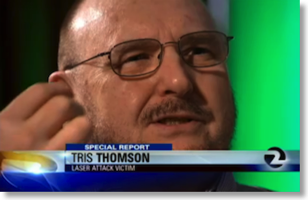Home
A comprehensive resource for safe and responsible laser use
US: Man says laser aimed 1/4 mile away caused retinal injury
20 Feb 2013 -- Categories: Eye effect or injury
A San Francisco man says a laser beam aimed from a distance of 1/4 mile caused a permanent injury in his right eye in December 2012. He now uses a magnifying glass, and a computer keyboard with larger letters to do his job.

Tris Thomson of San Francisco was in the Mexican Riviera on a sailboat at sunset, when someone in an apartment building aimed a green laser at the boat. Thomson felt “a slight bit of pain in the eyeball. A little searing, like almost you get burnt real quickly or something,” he told KTVU TV, which reported that an “eye x-ray” showed a black blotch on his retina.
The news story quoted ophthalmologist Dr. Vineet Batra as saying that he “sees patients injured by laser pointers about once a month.”
From KTVU.com. For an analysis of this case by LaserPointerSafety.com, click the “Read More…” link. Thanks to Capt. Dan Hewett of the FDA/CDRH for bringing this to our attention, and to Greg Makhov of LSDI for assistance with the analysis.
Analysis by LaserPointerSafety.com
The stated distance was 1/4 mile, or 1,320 feet. What type of beam could have caused the described injury at such a distance?
The short answer is that the laser must have been very high powered. It was not a pointer or any commercially available handheld laser.
If it had a continuous beam, the power would have to be in the 7.3 to 73 watt range. This is 1600 to 16,000 times more powerful than the highest laser allowed to be sold as a pointer in the U.S. (5 milliwatts), and it is about 3.5 to 35 times more powerful than the highest-power commercially available handheld laser (2 W, 1.5 mrad).
The chart below shows this in detail. It shows hazard distances for selected continuous-wave lasers (e.g., like pointers and handhelds). The colors in the bars have been very carefully chosen to indicate hazard levels.
- The first circle in each bar (orange) is the “ED50” distance. At this distance, there is a 50/50 chance of the laser causing the smallest medically detectable retinal lesion.
- The laser’s hazard continues to decrease until the second circle in each bar (green); this is the Nominal Ocular Hazard Distance. At the NOHD, the chance of a retinal lesion is “vanishingly small”.
- Beyond the NOHD, it is considered acceptably safe to look directly into a laser beam.

Click for a larger version of this chart
The graphic under the bars -- which is not to scale! -- shows a building on shore, from which a laser beam is aimed at a sailboat 1/4 mile (1,320 feet) away.
- Look first at the top group of lasers: actual, real-world lasers. The sailboat is well outside of the NOHD of any actual commercially available laser pointer or handheld (first three bars). It would take 7.3 watts of power before the sailboat is just inside the NOHD. To have a 50/50 chance of causing the smallest medically detectable retinal lesion, the laser would have to be 73 watts. This is not possible in any handheld, and is an expensive, professional industrial/scientific type laser.
- The second group of lasers are theoretical: if a laser’s beam can be made this narrow using lenses or special techniques. It would take a 3.3 watt handheld laser with an excellent 1 mrad beam, before the sailboat is inside the NOHD. Such a laser is not sold anywhere, to the best of our knowledge.
LaserPointerSafety.com conclusion
It is not possible for any known commercially available laser pointer or handheld laser to have caused an eye injury at the stated distance of 1/4 mile. Even at half that distance (1/8 mile), the most powerful commercially available handheld laser would have a very small chance of causing any lesion, much less the one described by Thomson.
We assume Thomson and his sailing companions saw a green beam. To cause the claimed eye damage, this could have been a pulsed (not continuous-wave) laser such as a Q-switched Nd:YAG. These are available surplus from medical or industrial users. Some light shows use these Nd:YAGs for mid-air beam effects -- but never for aiming at persons or their eyes. If someone on shore did aim an Nd:YAG or similar industrial-type pulsed laser, this could explain Thomson’s injury. More investigation and analysis is needed to confirm this hypothesis.